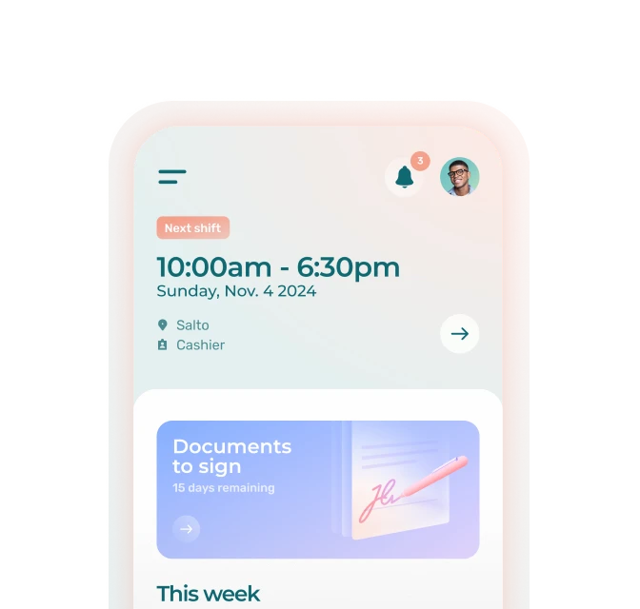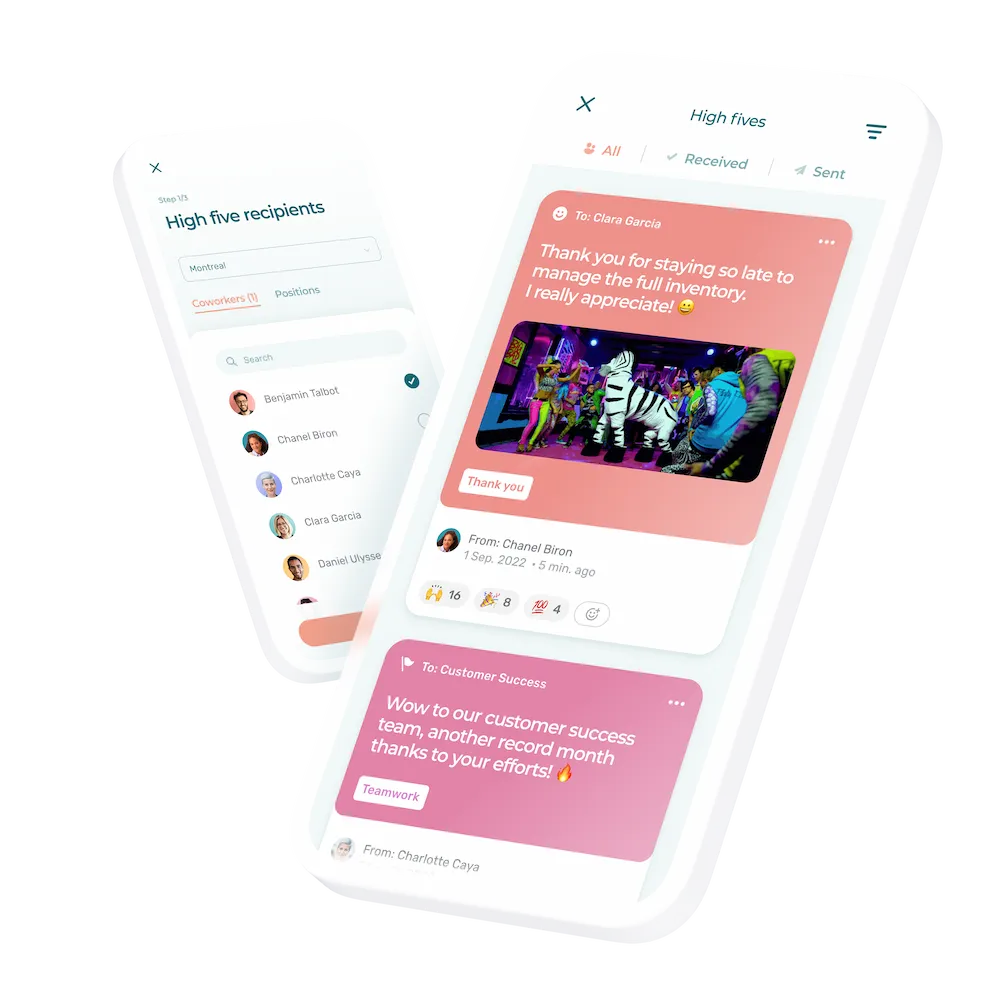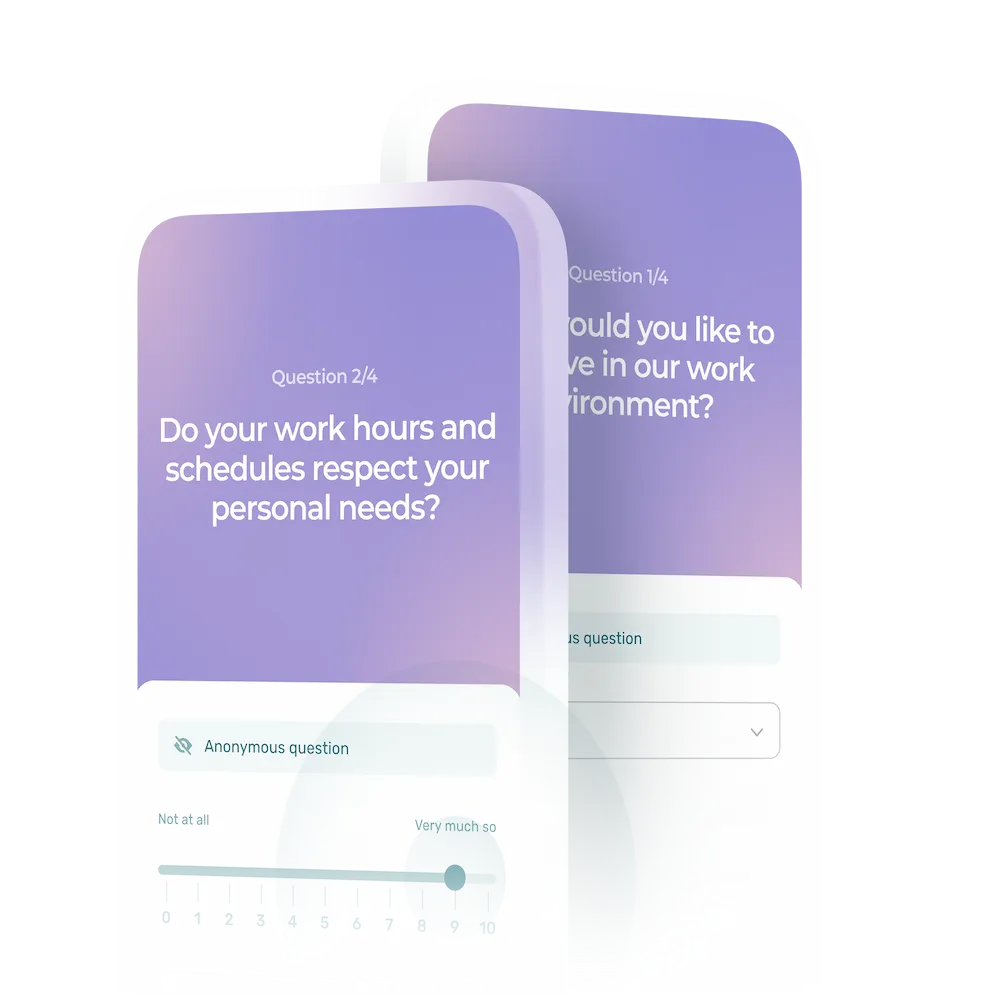Employee engagement, often confused with job satisfaction or motivation, is the ultimate measure of employee loyalty. Companies with committed employees tend to be healthier, both financially and overall.
Satisfied and motivated employees are obviously likely to be highly committed to their employer. But the concept of employee engagement is more durable than motivation or satisfaction, which can vary from week to week or even day to day.
Companies with more committed employees have a huge leg up on their competitors. In fact, by some accounts:
Highly committed employees contribute to a company’s growth up to two and a half times more than less committed employees.
This article:
- Presents a definition of employee engagement
- Lists the benefits of fostering employee engagement
- Explains the difference between committed and disengaged employees
- Gives 20 down-to-earth ideas to boost employee engagement
What Is Employee Engagement? A Definition
Employee engagement, or work engagement, is an individual’s sense of attachment and degree of loyalty to their employer.
Employee engagement means that an employee doesn’t just work for a salary or job security. They believe in the company’s mission and want to contribute to its success. Work engagement is a decisive factor in the sustainability of the employer-employee relationship.
The Benefits of Committed Employees
We often hear about staff turnover, which is something everyone wants to avoid at all costs. But I have to admit, I would be hard-pressed to choose between high turnover and a stable but disengaged team.
Which one do you prefer? 😉
Many studies have examined the effects of high work engagement, and the jury is in. Companies with high employee engagement score better in several respects:
- Productivity
- Profitability
- Customer satisfaction
- Product and service quality
- Return on investment
- Lower absenteeism
- Fewer workplace accidents and occupational diseases
- Reduced staff turnover
The Difference Between Committed and Disengaged Employees
A committed employee will go above and beyond their job duties because their job is meaningful and deeply important to them. Overall, committed employees perform better and are more motivated.
- They go beyond the call of duty
- They identify with the organization’s values
- They act as natural ambassadors for the organization, both with the entire team and with potential candidates
- They demonstrate a strong desire to stay with the organization
A disengaged employee, on the other hand, will demonstrate lower motivation and happiness at work. They stay on for more practical reasons, such as financial security or working conditions, for example. Unfortunately, disengagement has noticeable consequences for co-workers and managers alike.
- Less motivation
- Lower performance
- More stress or even anxiety
- Negative influence on the rest of the team
On average, an unengaged employee is said to represent 2 hours of lost productivity… per day! This figure speaks volumes.
20 Drivers of Employee Engagement
1. Set Up a Health and Wellness Program
Physically and psychologically healthy employees are higher-performing and more proactive. This has been proven by numerous studies. To promote and normalize self-care, it’s a good idea to set up a formal program. Give your employees access to perks connected to their health and well-being:
- Access to a spa
- A gym membership or exercise budget
- Yoga classes
- Meditation training
- Leave of absence without requiring a doctor’s note
- Wellness days for use when the employee’s health or morale is low, with no justification required
Try it now:
Think of things that promote employee well-being, i.e., things you would do if you wanted to take care of yourself. They don’t have to be expensive.
2. Make Flexibility the Norm
In 2023, flexibility continues to be highly prized: it’s the benefit that appears to be most important to employees. I can assure you that flexibility takes many forms and can be adapted to nearly any type of job. The important thing is for work-life balance to be accepted, understood and respected.
Try it now:
Flexible work schedules are certainly worth considering, even if you don’t offer telecommuting. Other possibilities include flexible days off, vacations and availability.
3. Promote a Healthy Work-Life Balance
The employee experience is significantly shaped by employees’ quality of life. In other words, the days when people lived to work are long gone—your employees consider it crucially important for the job they choose to allow them to live and not vice versa. This is a must.
Try it now:
Let your team members finish early to go to an appointment, or allow your student employees to take the week off when they have exams. Similarly, allow those same part-time employees to have a life by not making them work every Thursday, Friday and Saturday night.
4. Establish a Thoughtful Onboarding Process
The onboarding process has tremendous power. It sets the course for newcomers to your organization. The series of steps surrounding a new employee’s arrival shapes their first impression of their new workplace. It’s a period of learning and adjustment that has the potential to facilitate integration and acclimatization, as well as accelerating learning and fitting in with the rest of the team.
If neglected, however, this period is likely to make your new employee less committed and more likely to think about leaving, before you even know it.
Try it now:
Structure your onboarding, including communications before the first day and on the onboarding day itself. Think about all the steps leading up to arrival on the job as well as the first few weeks. Develop a consistent process and stick to it.
5. Rally Your Team Around a Common Project
A common project gives meaning to the work, and this in turn has a considerable impact on your employees’ engagement to your organization.
When team members work together on a common project, not only do they have a better grasp of the objective, but they also better perceive the importance of their work. This nurtures intrinsic motivation, i.e., motivation from within.
Try it now:
Embrace or even create opportunities to communicate your organization’s mission, values and vision. Emphasize the meaning of what you do at your restaurant, business or retirement home, and try to get your employees on the same page.
6. Give Employees Some Autonomy
Are you familiar with the psychological theory of self-determination? This theory aims to explain why individuals behave in autonomous and motivated ways. It is founded on three fundamental needs considered essential to motivation: autonomy, competence and relatedness.
Autonomy is one of the cornerstones of work engagement. An employee who feels they can leverage their strengths and demonstrate initiative and creativity in coming up with ideas and solutions is more likely to feel more committed.
Try it now:
If some employees’ roles are more about execution than decision-making, try to round things out with tasks that enable them to exercise greater autonomy and freedom in their choices and actions.
7. Prioritize Skill Development to Enhance Work Engagement
A full 94% of employees questioned by LinkedIn as part of its annual Workplace Learning Report (2023) said they would work for the same company for longer if it invested in their professional training.
Professional development is clearly important to most employees, enabling them to learn continuously, build up their professional self-esteem and feel more empowered.
What’s more, skill development often paves the way for career advancement, which is stimulating for your team members.
Try it now:
Be creative: today you can find training on just about any topic imaginable, in terms of both professional and personal development. Training in finance, nutrition or ergonomics may not have a direct bearing on your employees’ performance, but it will make them healthier and more satisfied people. The workplace is sure to benefit.
8. Build a Culture of Recognition
Recognition is a universal need, in both personal and professional relationships. Your employees need to feel that their work is appreciated, that they matter to you and to the organization.
Recognition at work favors motivation and well-being, and helps to reduce stress at work.
Recognition can take many forms in the world of work. Financial remuneration is one, but according to renowned psychosociologist Jacques Forest, it is less powerful, since it does not affect intrinsic emotions such as pride, self-esteem, feelings of worth and importance.
Other examples of recognition include thanks or congratulations, promotions, and non-monetary rewards.
Try it now:
Recognize your colleagues as often and as tangibly as possible. Highlight wins—if possible, in front of the entire team! Encourage your employees to recognize each other’s achievements as well, either through a kudos and thank-you box in the staff room, or through software designed for this purpose.
9. Really Get To Know Your Team
Getting to know your employees may seem trivial, but too many managers neglect to do so. Sometimes this happens because of a high turnover rate, which makes it difficult to keep track of new team members, and sometimes managers rarely mix with floor staff.
Yet this interest in your team will enrich relationships and help build trust. In turn, this will make employees more likely to confide in you. As a result, you’re more likely to learn that a given employee’s motivation is sagging, for example, and to be able to take action to address this.
Try it now:
To achieve this, meet one-on-one with each employee at least once a month. By all means, talk about work, but also branch out to other topics! Ask questions and… listen!
10. Inspire Transparent Communication
Transparent communication creates a climate of trust within a company, which in turn fosters commitment. Who wouldn’t want to stay with an organization where you know what to expect and where people tell things as they are?
At Agendrix, we politely call this practice No Bullshit 😂. We practice straight talk—whether among employees, between managers and employees, or with customers.
Try it now:
There are many ways to promote transparent communication. Making salaries and salary scales known, for example, is a good first step in demonstrating that everyone is being treated fairly and that things are kept out in the open. Another good practice is to discuss the state or progress of the company, or a more difficult period, to help foster a bond of trust and transparency.
11. Develop Authentic Relationships
When it comes to developing genuine relationships, transparent communication is key. But there’s more to it than that.
Opening up and being vulnerable in front of others creates an emotional connection, a feeling that everyone can be welcomed just as they are.
There was a time when the preferred management style was one in which managers remained unreachable atop their ivory towers. Those days are long gone.
Managers are expected to be vulnerable on certain occasions. For example, they are now encouraged to mention when they are more tired or going through a rough patch.
This builds solid, genuine relationships between staff and managers. And in turn, these relationships help develop strong work engagement.
Try it now:
Show your vulnerability whenever possible, during one-on-ones or team meetings. If you’re tired, haven’t been sleeping well lately because of your young child, etc., simply say so. Your employees will automatically know that you’re aware that these circumstances can happen.
12. Plan a Budget for Team Building
Team building is no longer unknown to most managers. It goes without saying that regularly getting together as a team fosters cohesion, team spirit and strong, resilient relationships.
In fact, strong, close-knit teams have been shown to improve employee retention. In other words, the benefits of team building encourage employee engagement.
Try it now:
To make team building a habit, establish a monthly, bi-monthly or even quarterly budget for team activities. Motivate your team by appointing a committee to organize the activities, and ask your employees for ideas on what they would like to do.
13. Conduct Systematic Exit Interviews
Who better to tell you what can be improved at your organization than a departing employee? It’s surprising to me that exit interviews aren’t more common!
To improve, and avoid repeating the same mistakes, examine the reasons why people leave your organization. By the way, if you’re not familiar with this practice, here are 50 ideas for questions to ask during an exit interview.
Try it now:
If you have a very high turnover rate, you may not want to interview every single person who leaves. Instead, you can select only interviewees who stayed on for a minimum number of months after hiring, say, 6 months or 12 months.
14. Try Stay Interviews
A stay interview is similar to an exit interview, but is conducted with an employee who is still employed at your company. The aim is first and foremost to retain the employee, but also to assess their commitment to the company. To do so, a manager discusses several topics with them:
- The employee’s career goals
- The factors that keep them employed with you
- The aspects of their job they enjoy most
- Areas where they would like to see improvements or changes
- Opportunities for professional development within the company
- What might make them consider leaving the company
Try it now:
Test the stay interview with an employee you consider committed, but also with an employee you’d like to keep but whom you suspect to be somewhat disengaged. Perhaps the interview might carry some weight in the balance?
15. Nourish a Culture of Feedback
Employees expect to receive constructive or negative feedback from their manager from time to time. But a culture of feedback goes both ways. It also means making room for feedback from employees to managers.
A 2014 study by Jack Zenger and Joe Folkman published in the Harvard Business Review showed that employees prefer corrective feedback over positive feedback, whereas managers used to believe the exact opposite.
Try it now:
Regularly survey your team to gather feedback—and above all, take action on what they tell you. Ask questions and take steps to remedy the situation. For your part, when you think of expressing criticism to an employee, rephrase it as constructive feedback. Remember that if you declare that you encourage your team to give feedback, but when you receive comments, your own reaction is to ignore them or, worse, to react poorly… this is not a culture of feedback… nor is it transparent communication. 😉
16. Make Normalizing Errors a Part of Your Culture
Normalizing errors is an essential process for managers in any industry. This starts with you, and applies to your team too. The idea is to name your mistakes openly and acknowledge your responsibility.
This improves transparency and enables the organization to evolve and employees to grow. Also, if your employees feel that mistakes are accepted and considered normal at your company, they’ll be more inclined to admit them, which is positive for all sorts of reasons.
A company where employees are fearful of being called out, and afraid for their job security if they make a mistake, will breed stress, a negative team atmosphere, and eventually, employee disengagement.
Try it now:
At your team meetings, encourage your employees to name a challenge they encountered and what they learned. If you made a mistake, say so, and mention what good came from it as well. Talking positively about mistakes helps everyone come to terms with them as learning opportunities.
17. Openly Promote Respect for Boundaries
Respecting boundaries at work is crucial to promoting a healthy, productive and respectful work environment. It’s absolutely impossible to be satisfied and happy at work if you and other people fail to respect your boundaries.
To promote respect for boundaries, it’s crucial to lead by example. If your team sees you say yes when you really don’t want to, or take a meeting outside your schedule when that time was reserved for your personal life… you can be sure they’ll feel expected to do the same.
Try it now:
Start by respecting your own boundaries. For example, tell your team that you don’t answer emails and text messages outside working hours, except for real emergencies. Be a role model in this respect.
18. Continuously Develop Your Leadership
For a manager, leadership is more important than technical skills. Emotional intelligence and active listening, for example, are skills you need to master and/or develop in order to be a good leader for your team.
A good boss is undoubtedly the single most influential factor in work engagement, since they influence the entire work atmosphere, and by the same token, the employee experience at your organization.
Try it now:
Educate yourself on what makes a better leader. Emotional intelligence and active listening are just two examples among many. Take training, read, and ask your colleagues for feedback—what do they think you could improve in terms of your leadership?
19. Ask Your Team to Evaluate Managers
Employees who are asked for their opinion on their experience at an organization feel respected, involved in their future, and heard in their needs and concerns—all aspects that boost their commitment.
What’s more, the answers you receive are a goldmine of information for pinpointing any points of dissatisfaction and determining what you need to work on.
Try it now:
Ask your team to evaluate you as a manager, via anonymous surveys, so that they feel safe answering candidly. You can also try out 360 evaluations for managers within your company.
20. Provide Opportunities for Teamwork
Working on team projects with colleagues can strengthen a sense of belonging and commitment. How, you ask? Think about how you feel when you take part in a team sport, or when you’ve had to collaborate with others to achieve a common goal. That emotion is deep and compelling.
Try it now:
If some of your employees have more solitary jobs, try to create opportunities for them to take part in an extra project or complete a task as a team. And if this really isn’t possible, consider team building!
Employee Engagement: The Ultimate Measure of Your Team’s Loyalty
By now, you’ve no doubt grasped the importance of fostering committed team members in order to improve your organization’s retention and overall health.
And you likely have no shortage of ideas on how to accomplish this.
Bear in mind, however, that whatever action you take must be genuine and authentic, otherwise your employees are unlikely to buy into it.













